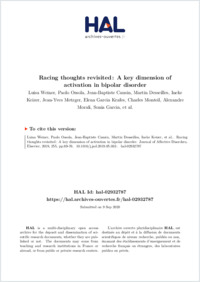Racing thoughts revisited: A key dimension of activation in bipolar disorder.
- Weiner L INSERM U1114, Strasbourg, France; Psychiatry Department, University Hospital of Strasbourg, Strasbourg, France. Electronic address: Luisa.weiner@chru-strasbourg.fr.
- Ossola P Department of Medicine and Surgery(,) Università di Parma, Parma, Italy.
- Causin JB INSERM U1114, Strasbourg, France; Psychiatry Department, University Hospital of Strasbourg, Strasbourg, France.
- Desseilles M University of Namur, Namur, Belgium.
- Keizer I University Hospital of Geneva, Geneva, Switzerland.
- Metzger JY Psychiatry Department, Hôpitaux Civils de Colmar, Colmar, France.
- Krafes EG Psychiatry Department, Hôpitaux Civils de Colmar, Colmar, France.
- Monteil C Psychiatry Department, Hôpitaux Civils de Colmar, Colmar, France.
- Morali A Etablissement Public de Santé Alsace Nord, Brumath, France.
- Garcia S Etablissement Public de Santé Alsace Nord, Brumath, France.
- Marchesi C Department of Medicine and Surgery(,) Università di Parma, Parma, Italy.
- Giersch A INSERM U1114, Strasbourg, France.
- Bertschy G INSERM U1114, Strasbourg, France; Psychiatry Department, University Hospital of Strasbourg, Strasbourg, France.
- Weibel S INSERM U1114, Strasbourg, France; Psychiatry Department, University Hospital of Strasbourg, Strasbourg, France.
- 2019-05-27
Published in:
- Journal of affective disorders. - 2019
Bipolar disorder
Crowded thoughts
Mixed depression
Racing thoughts
Adult
Affect
Bipolar Disorder
Cyclothymic Disorder
Depressive Disorder
Female
Humans
Irritable Mood
Male
Middle Aged
Surveys and Questionnaires
Thinking
English
BACKGROUND
Racing and crowded thoughts are frequently reported respectively in manic and mixed episodes of bipolar disorder (BD). However, questionnaires assessing this symptom are lacking. Here we aimed to investigate racing thoughts across different mood episodes of BD through a self-report questionnaire that we developed, the 34-item Racing and Crowded Thoughts Questionnaire (RCTQ). In addition to assessing its factor structure and validity, we were interested in the RCTQ's ability to discriminate mixed and non-mixed depression.
METHODS
221 BD patients and 120 controls were clinically assessed via the YMRS (mania) and the QIDS-C16 (depression), then fulfilled the RCTQ, rumination, worry, and anxiety measures. Three depression groups were operationalized according to YMRS scores: YMRS scores 2 > 6 and YMRS scores = 1 or 2, for respectively mixed and non-pure depression, and YMRS = 0 for pure-depression.
RESULTS
Confirmatory factor analysis showed that the three-factor model of the RCTQ yielded the best fit indices, which improved after the removal of redundant items, resulting in a 13-item questionnaire. Hypomanic and anxiety symptoms were the main predictors of scores; rumination was not a significant predictor. RCTQ results were similar between mixed groups and non-pure depression, and both were higher than in pure-depression.
LIMITATIONS
Patients' pharmacological treatment might have influenced the results.
CONCLUSIONS
The 13-item RCTQ captures different facets of racing thoughts heightened in hypomanic and mixed states, but also in depression with subclinical hypomanic/activation symptoms (e.g. non-pure depression characterized by enhanced subjective irritability), suggesting that it is particularly sensitive to activation symptoms in BD, and could become a valuable tool in the follow-up of patients.
Racing and crowded thoughts are frequently reported respectively in manic and mixed episodes of bipolar disorder (BD). However, questionnaires assessing this symptom are lacking. Here we aimed to investigate racing thoughts across different mood episodes of BD through a self-report questionnaire that we developed, the 34-item Racing and Crowded Thoughts Questionnaire (RCTQ). In addition to assessing its factor structure and validity, we were interested in the RCTQ's ability to discriminate mixed and non-mixed depression.
METHODS
221 BD patients and 120 controls were clinically assessed via the YMRS (mania) and the QIDS-C16 (depression), then fulfilled the RCTQ, rumination, worry, and anxiety measures. Three depression groups were operationalized according to YMRS scores: YMRS scores 2 > 6 and YMRS scores = 1 or 2, for respectively mixed and non-pure depression, and YMRS = 0 for pure-depression.
RESULTS
Confirmatory factor analysis showed that the three-factor model of the RCTQ yielded the best fit indices, which improved after the removal of redundant items, resulting in a 13-item questionnaire. Hypomanic and anxiety symptoms were the main predictors of scores; rumination was not a significant predictor. RCTQ results were similar between mixed groups and non-pure depression, and both were higher than in pure-depression.
LIMITATIONS
Patients' pharmacological treatment might have influenced the results.
CONCLUSIONS
The 13-item RCTQ captures different facets of racing thoughts heightened in hypomanic and mixed states, but also in depression with subclinical hypomanic/activation symptoms (e.g. non-pure depression characterized by enhanced subjective irritability), suggesting that it is particularly sensitive to activation symptoms in BD, and could become a valuable tool in the follow-up of patients.
- Language
-
- English
- Open access status
- green
- Identifiers
-
- DOI 10.1016/j.jad.2019.05.033
- PMID 31129462
- Persistent URL
- https://sonar.rero.ch/global/documents/242793
Statistics
Document views: 19
File downloads:
- fulltext.pdf: 0
